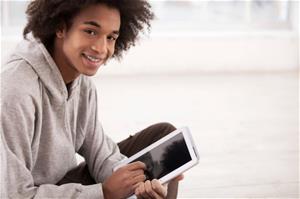 In a 2012 Journal of Literacy Research article titled, "Rereading 'A Pedagogy of Multiliteracies'," authors Kevin Leander and Gail Boldt urge educators to move from a perspective on literacy as passive consumption of texts to understanding and enacting intentional literacy practices. How students communicate and access meaning in 2017 is not always demonstrated by reading a text or writing a sentence.
In a 2012 Journal of Literacy Research article titled, "Rereading 'A Pedagogy of Multiliteracies'," authors Kevin Leander and Gail Boldt urge educators to move from a perspective on literacy as passive consumption of texts to understanding and enacting intentional literacy practices. How students communicate and access meaning in 2017 is not always demonstrated by reading a text or writing a sentence.
How do students experience multimodal literacies throughout the day, every day? Let’s follow the usual morning routine for one 12-year-old student, Will.
Will was nervous about the first day of seventh grade. His school had emailed his parents a welcome letter along with his schedule, list of required school supplies, and first day reminders. The night before school started, Will’s mom read this on her computer. Across the table, Will watched a fellow student’s YouTube channel, where she video blogged, or “vlogged,” about her first day nervousness. He looked up from his iPhone to share what his fellow student said with his mom, and to say how relieved he was that others felt the same way.
Will’s mom noted that there would be no school buses for seventh grade. Together, Will and his mom used a public transit app to configure his journey on the first day of school. While Will checked out four possible routes, his mom connected to a social media group that was created to support the parents and caregivers of seventh graders. That night, Will went to sleep knowing what to expect, how to get to school, and that everyone else was feeling anxious as well.
Will wakes up to his iPhone playing a popular song. As he walks to the kitchen for breakfast, he reads over the weather alerts, Buzzfeed notifications, and texts from his friends. Will laughs as his friend John sends out a musical invite encouraging his “fans” to watch him comb his hair on the first day of school. Will types a quick comment to his friend telling him that he looks great and will see him at school. As he sits down to eat breakfast, his phone reminds him that his citizens are going to revolt if he doesn’t get more food. Will jumps into his SimCity app to keep his virtual society happy for the day. Will finds his Fitbit as he has a soccer practice after school and wants to ensure he reaches 10,000 steps by dinner time. He has been tracking his steps as well as his heart beat at soccer practices, as he thinks his coach is making them run too much.
When Will gets on the bus, his friend John pulls out his phone to show Will pictures of possible new hairstyles. John had already posted various remixes of “possible John with this hair” images on Instagram and Snapchat, and he was watching to see which photos were getting the most likes. Sandra (the vlogger) introduces Will to her cousin from Mexico, and Will quickly uses a translator app on his iPhone to welcome her to Canada.
Finally, Will arrives at school, throws his bag in his locker and rushes to class. As he enters his classroom his teacher greets him with a warm hello, then asks him to put his cell phone in a basket. He will get it back at the end of class. The teacher then starts the class by saying, “Take out a piece of paper, and write a 500-word paragraph that describes who you are.” Will looks longingly over at his phone and considers the photos, videos, texts, games, apps that help describe who he is. Then he turns back to his paper and dutifully writes his paragraph. As the bell rings for the class, Will hands in his assignment and takes his phone out of the basket.
Did Will’s teacher miss out on an opportunity to learn more about the “real” Will? How can we, as educators, best integrate text focused and multimodal literacies in our learning environments? What are you doing?
 Verena Roberts is a doctoral student at the University of Calgary and an educational technology learning specialist at Rocky View Schools.
Verena Roberts is a doctoral student at the University of Calgary and an educational technology learning specialist at Rocky View Schools.
 Susan Noble is a master’s student at the University of Calgary and a literacy learning specialist at Rocky View Schools.
Susan Noble is a master’s student at the University of Calgary and a literacy learning specialist at Rocky View Schools.
This article is part of a series from the International Literacy Association Technology in Literacy Education Special Interest Group (TILE-SIG).